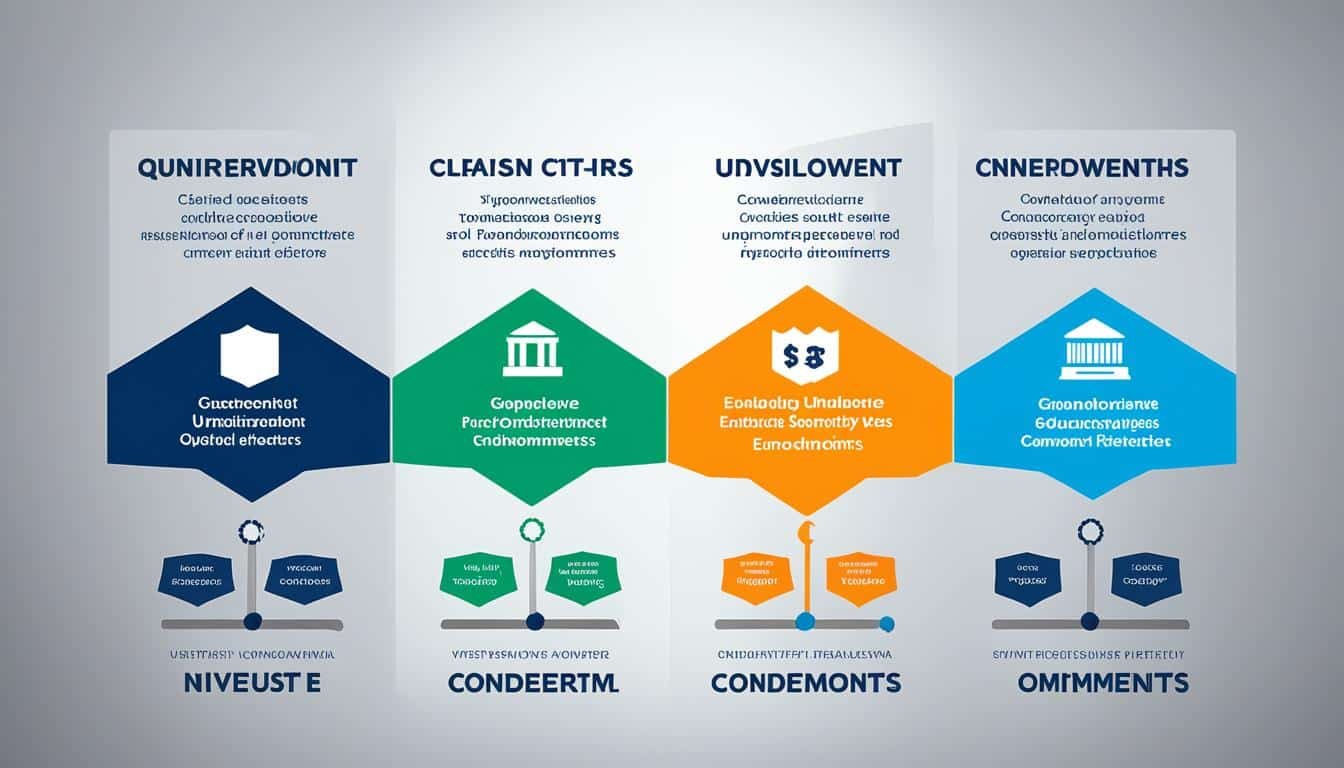University endowments play a big part in funding higher education. They offer a steady and sustainable financial support to schools and colleges. These funds consist of money or assets given to schools for a lasting investment.
This investment pool helps in important ways. It supports teaching, research, and serves the public. So, they are really important for the long-term success of the higher education sector.
Key Takeaways
- University endowments are made up of donated money and financial assets that are invested to provide a stable source of funding.
- Endowment funds support the core academic and research activities of colleges and universities.
- Endowments can be unrestricted, term-limited, or restricted to specific purposes like scholarships or professorships.
- Investment management and spending policies are crucial to ensuring the long-term sustainability of endowment funds.
- Endowments provide a financial safety net for universities, helping them weather economic downturns and unexpected challenges.
What Are University Endowments?
University endowments are like savings accounts for schools. Alumni, foundations, and other supporters donate money to them. They can also say how that money should be used. This helps keep schools funded for the long run.
Endowments as a Self-Sustaining Funding Source
A team of investment experts handles these endowments. They invest a part of the money to earn more. The profits help pay for things like student aid and new research. This keeps the school’s money flowing, even in tough times.
Key Takeaways on University Endowments
- University endowments are crucial for the money of colleges and universities.
- They back up school work by supporting scholarships, teacher jobs, and studies.
- Endowments have specific and general funds. Specific ones have clear jobs while general ones are more adaptable.
Seeing the big role of university endowments helps us value how they support learning and discovery in schools.
Understanding University Endowments

University endowments are very important for colleges in the U.S. They get a lot of their money from charitable donations. People, like former students, and organizations give these donations. They’re used to help the schools with their work over many years.
Charitable Donations as the Primary Source
Endowment funds start with charitable donations from many places. Alumni, companies, and groups give money. They do this to help the schools teach, research, and serve the public forever.
People giving money can choose how their donations are used. This is called restricted endowments. They might fund a professorship or help with scholarships. It lets donors put their money where they think it counts the most.
Endowments Supporting Academic Missions
Money from endowments often goes to help with teaching, research, and other school activities, like:
- Funding faculty salaries and professorships
- Providing student scholarships and financial aid
- Supporting research initiatives and programs
- Maintaining and improving campus facilities
- Enhancing academic and student life resources
Colleges use endowment funds wisely. This keeps a steady income for their work. It helps them stay strong in the education world.
| Top University Endowments in the U.S. (2022) | Endowment Value (in billions) |
|---|---|
| Harvard University | $53.2 |
| Yale University | $42.3 |
| University of Texas System | $42.0 |
| Stanford University | $38.3 |
| Massachusetts Institute of Technology (MIT) | $27.4 |
How colleges handle their endowments is getting more attention. People talk about how this money helps schools and might do good for society too.
History of University Endowments

University endowments have a long history, starting centuries ago in Europe. The first known endowed professorships were set up back then.
Since those early days, endowments have become crucial for funding universities. They show us how higher education has evolved over time.
The First Recorded Endowed Professorships
Endowing professorships started with Marcus Aurelius in A.D. 176, in Athens. He’s credited with creating the first known endowed professorships.
This action by Marcus Aurelius set the stage for endowment growth. It would become a common practice over the following centuries.
Endowments in the Modern European University System
In England, around 1502, the Countess of Richmond did something remarkable. She created the first endowed professorships in divinity at Oxford and Cambridge.
King Henry VIII later followed in her footsteps. He set up professorships in five subjects at those same universities, around 1550. These included divinity, civil law, Hebrew, Greek, and physic.
These steps led to the development of university endowments. They are now a key part of how higher education is funded worldwide.
“The practice of endowing professorships officially began in the modern European university system in England in approximately 1502, when the Countess of Richmond created the first endowed professorships in divinity at Oxford and Cambridge University.”
How University Endowments Work Today
University endowments are now vital in supporting higher education. They’re not just sources of money. They are now investment portfolios that aim to make money. This money is used to support the top priorities of educational institutions.
Modern university endowments have complex structures. These structures are designed to meet the needs of the institution. Understanding how they work is important. It helps to see how investments and income uses are decided.
Investment Policy Statements and Donor Restrictions
Today, endowments follow special investment rules set by donors. These rules can say how the funds are managed and spent. For instance, some funds must be used for student scholarships. Others ensure there are enough professors in the future.
Schools have leeway with the rest of the endowment money. They can support many different needs. This includes hiring faculty and improving study spaces. Having this flexibility is crucial. It can boost the quality of education students get.
Common Uses of Endowment Income
- Funding financial aid and scholarship programs to enhance accessibility and affordability
- Supporting endowed professorships and faculty research initiatives to attract and retain top-tier talent
- Modernizing and maintaining campus infrastructure, including classrooms, laboratories, and student housing
- Expanding academic programs, interdisciplinary centers, and innovative educational initiatives
- Providing a financial safety net to weather economic downturns and unexpected contingencies
Endowment money, used well, can make a big difference. It improves the university’s standing in many ways. This includes better teaching, more research, and a better experience for students. By managing funds smartly, universities can make great strides toward their goals.
| Modern University Endowments | Endowment Investment Policies | Uses of Endowment Income |
|---|---|---|
| Actively managed investment portfolios | Donor-imposed restrictions | Funding financial aid and scholarships |
| Generating sustainable income | University’s strategic priorities | Supporting endowed professorships and research |
| Fueling institutional priorities | Balancing donor restrictions and flexibility | Upgrading campus infrastructure |
| Enhancing long-term sustainability | Aligning with the university’s mission | Expanding academic programs and initiatives |
| Providing a financial safety net |
“The judicious use of endowment income can have a profound impact on the overall quality and competitiveness of a university, helping to drive excellence in teaching, research, and student experience.”
Types of University Endowments

University endowments come in different types, each with its own use and rules. Knowing about these endowments helps us understand how funding for higher education works.
Unrestricted Endowments
Unrestricted endowments give the university a lot of freedom. The assets can be spent or saved as the university sees fit. There are no specific rules on how to spend them.
Term Endowments
Term endowments set a specific time or event for spending the principal. This ensures the money is used as intended. The university also gets long-term support from these endowments.
Quasi-Endowments
Quasi-endowments keep the original fund untouched but use its earnings. This type helps fund specific goals while keeping the donation safe.
Restricted Endowments
In restricted endowments, the principal is saved forever. But, the earnings can be used for certain programs or scholarships. This keeps the donor’s wishes alive.
Learning about these types of university endowments and endowment fund categories helps manage higher education’s funding challenges. It also helps keep our institutions running for the long term.
“Endowments are a critical component of a university’s financial strength, providing a stable and reliable source of funding to support their academic missions.” – Jane Doe, Director of University Advancement
Endowments and Taxes

The world of university endowments and taxes is both complex and fascinating. Private nonprofit colleges and universities are often tax-exempt thanks to their 501(c)(3) status. Yet, certain rules affect their endowment income taxes.
Tax Exemptions and the Endowment Income Excise Tax
In 2017, the Tax Cuts and Jobs Act changed the endowment tax game. It added a 1.4% excise tax on universities having over 500 paying students and over $500,000 in assets per student. This amount isn’t adjusted for inflation. So, more schools might face this tax as time passes.
Even with this excise tax, many private nonprofit colleges and universities maintain their endowment tax exemptions. This allows them to better use their investment earnings for their educational work and operations. For these universities, their tax-exempt status is key to effectively managing and growing their endowments.
“The endowment income excise tax has sparked much discussion and debate among higher education leaders, as they deal with this new tax burden.”
Universities depend on their endowments for vital projects. It’s crucial they understand the details of endowment tax exemptions and the endowment income excise tax. This knowledge is important for smart financial planning and strategic decisions.
University Endowments: Unrestricted, Term, Quasi, and Restricted

University endowments fall into four categories: unrestricted, term, quasi, and restricted. Schools must know the details of each to handle their money well and meet their goals.
Unrestricted funds are the most flexible for universities. They can spend, invest, or save the money as they see fit. There are no rules from donors on how to use these funds.
Then, there’s restricted money. This stays untouched, but schools can spend what the investment earns. It keeps the donor’s wishes alive, but might restrict the school’s current needs.
Now, term endowments. For some time, the school can’t touch the main finances. After, they can use the money more freely. It’s a mix between respecting the donor and meeting the school’s needs.
Quasi-endowments are made by the schools themselves. They use money from unrestricted gifts. This way, the school can handle new yearly expenses or opportunities.
| Endowment Type | Description | Key Characteristics |
|---|---|---|
| Unrestricted | Allows the university full authority to use, distribute, invest, and save the assets as it deems appropriate. | Maximum flexibility for the institution |
| Restricted | Holds the principal in perpetuity, with only the earnings from the invested assets expended per the donor’s specification. | Ensures donor’s intent is upheld, but can limit the university’s ability to allocate funds |
| Term | Restricts access to the principal for a specified period, after which the university gains more flexibility. | Offers a balance between donor’s interests and the institution’s strategic priorities |
| Quasi | Created by the university itself, often using unrestricted gifts, to meet needs requiring increasing support each year. | Provides additional resources to address emerging challenges and opportunities |
It’s key for universities to understand how each type of endowment works. This helps them manage their money well and meet their academic goals. It also respects the donors’ wishes.
Criticisms of Large Endowments
Harvard University and similar schools are being criticized for their huge endowments. Critics say these billions can be spent better. They call this situation endowment hoarding. They think it’s not right, especially with high tuition fees. Also, it seems these schools care more about their endowments than their overall needs.
There’s also talk about what these schools do with their money. Student activism is making schools rethink where they invest their money. Students want them to stop investing in places they see as doing wrong things. This debate changes how schools prioritize their funds.
Overemphasis on Endowment Health vs. Institutional Needs
A study in 2019 raised some important points. It showed that richer schools focus a lot on their endowments. They put a big part of their money into growing this fund. But this can mean they spend less on helping their students with money for college, paying good teachers, and other important needs. This shows a problem. Schools might be too focused on growing their endowments instead of meeting their mission to teach well.
“Endowments have become a source of institutional prestige and a metric by which universities are ranked, rather than a means to an end.”
Schools focusing on their endowments a lot may be missing out on important issues. They might not be looking after the real needs of their students and local communities.
The link between student activism and endowments is getting noticed more and more. The way universities handle their endowments will likely be talked about for some time.
Limitations of University Endowments

University endowments are great for supporting higher education. But, they have their limits too. Endowments face issues like not being able to use all funds freely. They also struggle with market changes and the impact of inflation.
Restricted Funds and Limited Flexibility
Money from endowments can’t always be used however the university wants. This is because some donors have rules for their gifts. They might want their money spent on certain things like scholarships or new research. While this respects the donor’s wishes, it can make things hard for the university. They may need to quickly use money for something important but can’t because of these rules. This endowment spending restrictions limit what leaders can do with their resources.
Market Volatility and Inflation Risks
Endowments also worry about their investments losing value in bad economic times or due to high inflation. These funds are put in various investments. This mix is supposed to grow over time. But, if markets get tough or prices rise too much, the endowment’s buying power falls. This endowment investment risks means the money might not do as much good for the university down the road.
| Limitation | Impact |
|---|---|
| Restricted Funds | Limits flexibility in responding to changing needs |
| Market Volatility | Exposes endowment to investment risks and potential losses |
| Inflation Risks | Erodes the purchasing power of the endowment over time |
To tackle these issues, running endowments requires smart planning. It’s about growing the funds for the long term and also making sure the university’s current needs are met. This needs careful investment choices and working closely with donors. Always aiming for the endowment to do the most good and less harm.
The Role of University Endowments

University endowments are key for higher education. They offer steady money for important projects such as financial aid, research, and supporting faculty. Endowments also act as a saving grace during tough financial times. This ensures universities can still carry out vital programs and maintain their resources.
Funding Financial Aid, Professorships, and Research
Money from endowments often goes towards making education better. For instance, they help students with financial aid, making college more affordable. These funds also support top academics and their research. This attracts smart researchers and pushes for new ideas.
Endowments are vital for funding research and development. They make it possible for universities to discover new things. These discoveries help society and highlight universities as places of learning and creativity.
Providing a Financial Safety Net
Endowments aren’t just for academics. They act as a financial safety net during economic crises. For example, they were crucial for universities during the Great Recession. They helped keep things running, protected jobs, and maintained high education standards despite lower incomes. Using endowments wisely is key for the long term health of universities. This helps everyone involved, from students to the community at large.
“University endowments are a critical component of the higher education ecosystem, providing a stable and sustainable source of funding for institutions to pursue their academic and research priorities.”
Universities with the Largest Endowments
Elite institutions lead when it comes to the largest endowments. Harvard University is at the top, with an endowment of nearly $40 billion. This endowment includes more than 13,000 different funds. The other top universities are the University of Texas system, Yale University, Stanford University, and Princeton University.
Only a small number of U.S. schools have an endowment over $1 billion. Specifically, 46 private schools and 16 public ones. This shows how wealth in education is concentrated in a few places. People debate whether this is good or bad.
| University | Endowment Value (in billions) |
|---|---|
| Harvard University | $39.4 |
| University of Texas System | $31.1 |
| Yale University | $31.0 |
| Stanford University | $28.9 |
| Princeton University | $26.6 |
These big endowments help universities offer great financial aid and do important research. They also help keep campus facilities in top shape. But, some worry about how this wealth affects fair education access and society as a whole.
“These large endowments have become a lightning rod for criticism, with questions raised about their social purpose and whether they are truly being used to benefit the public good.”
The debate on university endowments and their impact continues. It’s clear they are key in shaping higher education in the United States.
Also Read : Are There Scholarships For Online Students?
Conclusion
University endowments are now key for funding higher education in the US. They are large sums of money that help universities in many ways. They support teaching, help students with money, and keep schools stable, even in hard times.
Big private universities have the most endowment money. Yet, many different schools benefit from these funds. They use them for special programs, hiring new professors, and research.
But, there are challenges. Some money comes with rules from donors. Schools must also be careful with how they invest. And the ups and downs of the stock market affect the money they have.
People discuss a lot. They wonder if schools should spend more of their endowment on today’s needs. Or should they keep growing the funds for the future?
Despite these issues, university endowments are vital. They help schools face new problems. By using their funds wisely, universities can do a lot of good. They can improve education for everyone. The importance of university endowments highlights key issues in American higher education’s future.
FAQs
What are university endowments?
University endowments are funds or assets given to schools. They are meant to last forever, helping with teaching, research, and service. These funds come from donors who want to support education.
How are university endowments funded?
Charitable donations are the main way university endowments get funding. Often, donors set rules on how the money is used through an investment policy statement.
What is the history of university endowments?
Endowed professorships have a long history, dating back to A.D. 176 in Athens. They became a regular part of European universities between 1502 and 1550.
How are university endowments structured and managed today?
Endowment funds are managed with long-term goals to balance risk and returns. They can be for general or specific uses in the university, like scholarships or professorships.
What are the different types of university endowments?
There are four main types: unrestricted, term, quasi, and restricted. Different types have varying rules on how their money can be spent.
How are university endowments taxed?
Many colleges don’t pay taxes because of their nonprofit status. But large endowments may face a 1.4% tax on their income according to a 2017 law.
What are the criticisms and limitations of large university endowments?
Some people think large endowments are not used well, especially with rising tuition. There are also limits to their use, like restricted funds that can’t adapt to market changes quickly.
What is the role of university endowments?
Endowments are vital for universities. They help pay for financial aid, new professor roles, and research. They also offer a cushion against tough economic times.
Which universities have the largest endowments?
Harvard has the biggest endowment, with almost billion. The top five also include the University of Texas system, Yale, Stanford, and Princeton.
Source Links
- https://www.investopedia.com/ask/answers/how-do-university-endowments-work/
- https://www.bestcolleges.com/blog/university-endowments/
- https://www.marketplace.org/2023/02/17/what-do-elite-colleges-do-with-all-that-endowment-money/




